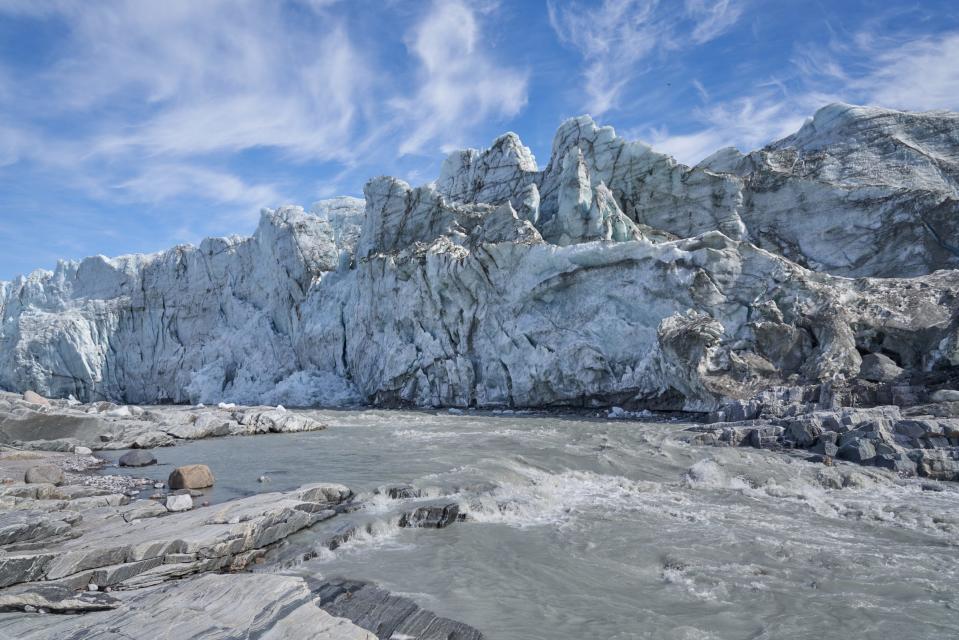Greenland sees hottest temps in 1,000 years. How its melting ice sheet has major impact on sea level
Even the most remote regions of the world aren't escaping the ravages of the warming climate, but what happens in Greenland isn't staying in Greenland.
Ice melt taking place as a result of warming temperatures over the island's ice sheet has become a "major" contributor to rising sea levels, a group of scientists reported in a study published Wednesday in the Springer Nature Portfolio journal.
They looked at temperatures over the ice sheet in central-north Greenland between 2001 and 2011 and found the decade was the warmest in the past 1,000 years, said Maria Hörhold, a study author and glaciologist at the Alfred Wegener Institute for Polar and Marine Research in Germany.
The likelihood that temperatures the researchers observed would have occurred under pre-industrial conditions is "almost zero," the study found.
Human-driven "global warming has reached the top of the ice sheet," Hörhold said.
IN GREENLAND: New population of polar bears hanging on despite rapidly changing climate

What to know about rising sea levels
Two things contribute to rising sea levels: Warmer oceans that expand to take up more space and melting glaciers and ice sheets.
The shrinking and melting of Greenland’s ice sheet over the past decade — driven by hotter summer temperatures — is likely unprecedented over 1,000 years, authors said.
The summer melt expands to higher elevations as temperatures warm, indicating an increased number and intensity of large-scale melt events that are likely to continue, the authors said.
"An increasing mass loss of the ice sheet is expected," they said.
Greenland's ice sheet plays an important role in the global climate system, storing a huge amount of water, Hörhold said. If unmitigated carbon emissions continue, she said the ice sheet is projected to contribute up to 19 inches of global mean sea level rise by 2100.
Other effects of climate change in the Arctic
The new study reflects similar findings from recent studies in Greenland and the Arctic. In December, the Oceanography Society published a special report on the Arctic, with articles by researchers working throughout the region.
It reported:
Researchers are seeing the impacts of warming on Arctic sea ice and that's affecting humans, flora and fauna.
A “dramatic increase in meltwater production.”
Melt volumes that exceed precipitation in some years, including a 14% increase in ice discharge in 1990-2015 compared to 1960-1989.
Substantial changes in sea ice cover over 40 years, including a decline in all months — strongest during summer — with earlier melt onset and later freeze-up.
Temperatures increase by 2.7 degrees: What's the significance?
In the new Greenland research, the scientists found temperatures in the study area were 2.7 degrees Fahrenheit warmer on average than during the 20th century.
If that figure sounds familiar, it's the same temperature increase — 1.5 Celsius — world leaders pledged to avoid when signing the Paris treaty in 2015.
While the rest of the planet looms ever closer to that global average increase, the study reported temperatures over central-north Greenland have been there for more than a decade.
The new study plugs an important gap in knowledge, showing that Greenland is hotter than at any time in the past 1,000 years, said Andrew Shepherd, director of the Centre for Polar Observation and Modelling at the University of Leeds in England.
“But the ice cores that are used in this study were collected more than a decade ago, and temperatures have risen even more since then," Shepherd said. "It’s a timely reminder that even the coldest parts of our planet are not isolated from the effects of global heating, and of course the impacts in this case will arrive at our doorsteps immediately as sea levels rise.”
Why there's reason to be hopeful
Greenland’s melting ice sheet is “a massive contributor to global sea level rise,” one contributor to the Oceanography special report, Jason Briner, told USA TODAY in an email Tuesday.
"All data point to that trend continuing,” said Briner, a geology professor at the University of Buffalo. “This is frustrating because humanity controls the knobs.”
But there’s reason to be hopeful, Briner said. Researchers also find that “if humanity acts, ice loss on Greenland will slow. The ice loss on Greenland is not irreversible.”
Dig Deeper
Melting Greenland ice sheet will send seas nearly a foot higher, study finds
Greenland hit with 'unusually extensive' melting of ice sheet
Fact check: Greenland still losing ice due to greenhouse gas emissions
What are the causes of climate change? Why humans are to blame.
Dinah Voyles Pulver covers climate and environment issues for USA TODAY. She can be reached at dpulver@gannett.com.
This article originally appeared on USA TODAY: Global warming is melting Greenland ice sheet, raising sea levels

